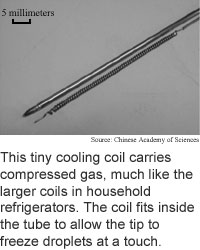
Micro tweezers have ice grip
As the field of microscopic machines heats
up, researchers are racing to find ways to manipulate minuscule objects.
Researchers from the Chinese Academy of Sciences have found that
cooling things down makes for a simple way to rotate, twist, stretch,
pick up and drop a wide range of microscopic items.
The researchers have constructed a freeze tweezer that uses the
freezing force of a small volume of ice to manipulate objects suspended
in a solution. Using a similar mechanism, they have made a simple electrical
valve for microfluidic devices that closes by freezing a liquid and opens
by thawing it.
The freeze tweezer uses high-pressure nitrogen gas running through
a tiny coil to freeze liquid between a probe tip and an object, effectively
gluing the tweezer and object together with a ball of ice. One or more
freeze tweezers can be used to manipulate objects of any shape and electric
charge, including biological objects, according to the researchers. The
device can also be used to cool or heat groups of molecules.
The researchers' prototypes had tips as small as 20 microns, which
is about one-quarter the width of a human hair. In theory, freeze tweezers
could be made as small as several dozen nanometers, according to the researchers.
A nanometer is one millionth of a millimeter.
The work appeared in the November 17, 2003 issue of the Journal
of Micromechanics and Microengineering.
Robot automates science
Chemicals map nanowire arrays
Badge controls displays
Neural-chaos team boosts security
Briefs:
Inkjet goes 3D
Nanotubes tied to silicon circuit
Micro tweezers have ice grip
Nanorings promise big memory
Protein orders semiconductor bits
Technique detects quantum state

Research Watch blog
View from the High Ground Q&A
How It Works
RSS Feeds:
News
Ad links:
Buy an ad link
Ad links: Clear History
Buy an ad link
|
TRN
Newswire and Headline Feeds for Web sites
|
© Copyright Technology Research News, LLC 2000-2010. All rights reserved.